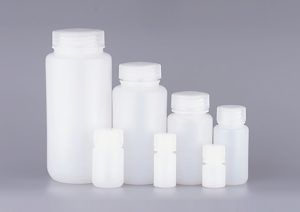Introduction
In the intricate world of laboratory research and experimentation, every detail matters. From the precision of instruments to the choice of materials, each component plays a crucial role in ensuring accurate results and maintaining safety standards. Among these components, the selection of appropriate storage vessels for reagents holds particular significance. In this article, we delve into the myriad advantages of using lab amber glass reagent bottles over alternative materials, highlighting their chemical compatibility, UV protection, transparency, durability, environmental considerations, and cost-effectiveness.

Plastic Media Bottle Reagent Bottle
Chemical Compatibility
One of the primary advantages of lab amber glass reagent bottles is their exceptional chemical compatibility. Unlike certain plastics that may react with or leach chemicals into stored reagents, amber glass maintains its integrity and purity, offering a reliable barrier against contamination. Whether containing acidic solutions, alkaline substances, or organic solvents, these bottles provide a robust shield, ensuring the stability and integrity of the stored reagents over time. This compatibility extends to a wide range of chemicals, making amber glass bottles a versatile choice for various laboratory applications.
UV Protection
Another significant benefit of lab amber glass reagent bottles is their ability to provide UV protection. Exposure to ultraviolet (UV) radiation can lead to the degradation or alteration of light-sensitive reagents, compromising their efficacy and reliability. However, amber glass bottles are specially designed to block harmful UV rays, safeguarding the integrity of the contents. By shielding the reagents from UV-induced degradation, these bottles help maintain their stability and potency, ensuring consistent performance in experimental procedures.
Transparency and Visibility
In the laboratory environment, clarity and visibility are essential for efficient workflow and accurate experimentation. Lab amber glass reagent bottles offer excellent transparency, allowing researchers to easily identify the contents without the need for opening the bottle. This clear visibility facilitates quick and reliable assessment of reagent levels and condition, enabling timely replenishment and maintenance of stock. Moreover, the transparent nature of amber glass enhances precision in measurements and dispensing, contributing to the overall accuracy and reproducibility of experimental results.
Durability and Safety
Durability and safety are paramount considerations in laboratory settings where accidents or mishaps can have serious consequences. Lab amber glass reagent bottles excel in both these aspects, thanks to their robust construction and resistance to breakage. Unlike flimsy plastic containers that may crack or deform under pressure, amber glass bottles withstand handling and storage challenges with ease, minimizing the risk of spills or leaks. Additionally, the inert nature of glass ensures that it does not interact with the stored reagents, preserving their purity and preventing contamination.
Environmental Considerations
As the global focus on sustainability intensifies, the environmental impact of laboratory practices comes under scrutiny. In this context, the choice of materials for reagent storage becomes significant, with glass emerging as a preferred eco-friendly option. Lab amber glass reagent bottles are recyclable, meaning they can be repurposed or transformed into new products at the end of their lifecycle. Furthermore, glass is inherently less harmful to the environment compared to certain plastics, which may release toxins or contribute to pollution. By opting for glass reagent bottles, laboratories can align with their commitment to environmental responsibility while maintaining high standards of performance and safety.
Cost-Effectiveness
While the initial investment in lab amber glass reagent bottles may seem higher than alternatives such as plastic, their long-term cost-effectiveness cannot be overlooked. Glass bottles offer superior durability and reusability, reducing the need for frequent replacements and minimizing operational expenses over time. Moreover, the prevention of reagent wastage and contamination-related costs further enhances their cost-effectiveness. A comparative analysis of costs versus benefits reveals that the value proposition of glass reagent bottles outweighs that of alternative materials, making them a wise investment for laboratories seeking efficiency and reliability.
Conclusion
In conclusion, the advantages of using lab amber glass reagent bottles in laboratory settings are multifaceted and compelling. From their exceptional chemical compatibility and UV protection to their transparency, durability, environmental friendliness, and cost-effectiveness, these bottles offer a comprehensive solution to the storage needs of reagents. By prioritizing the use of glass bottles, laboratories can uphold the highest standards of safety, reliability, and sustainability in their research endeavors. As the cornerstone of scientific inquiry, lab amber glass reagent bottles embody the principles of precision, integrity, and innovation that define the pursuit of knowledge.




